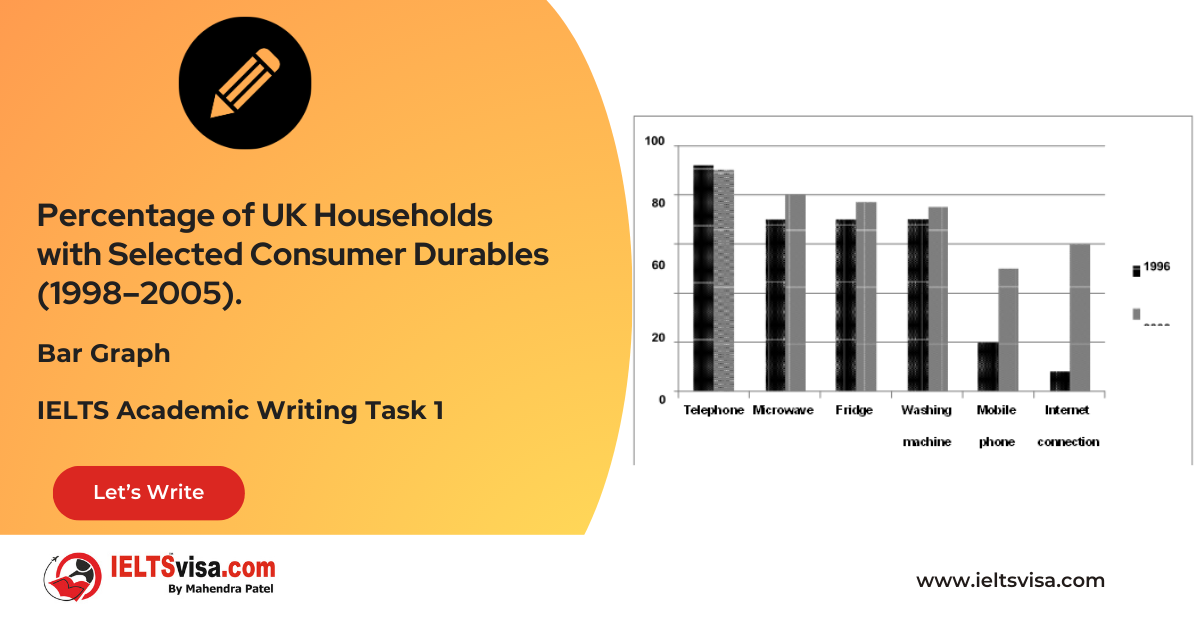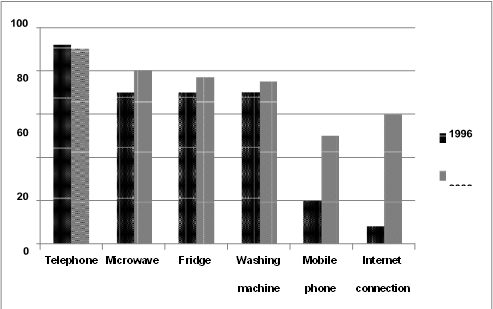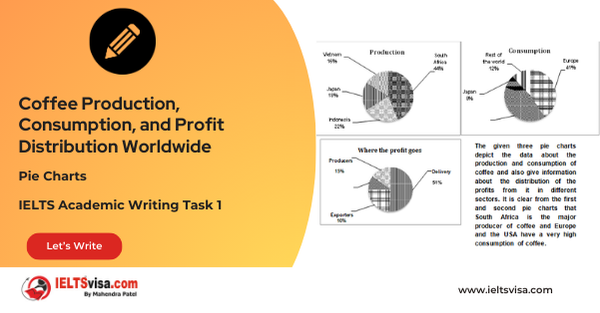Percentage of UK Households with Selected Consumer Durables (1998–2005)
IELTS Academic Writing Task 1 - Bar Graph
IELTS Writing Task 1 Question
The chart below shows the percentage of UK households with selected consumer durables between 1998 and 2005

Common questions for the consumer durables chart
1. Graph Type: Bar chart (or column chart).
2. Title: Percentage of UK Households with Selected Consumer Durables (1998–2005).
3. What are the units of measurement?: Percentage of households.
4. Who: Households in the United Kingdom.
5. When: The years 1998 and 2005.
6. Where: The United Kingdom.
7. Topic: The chart compares the percentage of UK households with selected consumer durables between 1998 and 2005.
Process Showing and Trends
Comparison 1 : Stability of Telephone Ownership
- Telephone ownership showed little change, maintaining close to 90% of households in both 1998 and 2005.
Comparison 2 : Increase in Modern Appliances
- The ownership of modern consumer durables like microwaves, fridges, and washing machines saw a gradual increase, with microwaves showing the highest rise (10%), while fridges and washing machines increased by 5%.
Comparison 3 : Significant Growth in Mobile and Internet Usage
- The most dramatic increases were in mobile phone ownership, which rose from 20% to 60%, and internet connection, which surged from 8% to approximately 60%, showing a threefold increase in mobile phone ownership and a substantial rise in internet access.
Sample Answer
The given bar chart illustrates the percentage of UK households owning selected consumer durables between 1998 and 2005. It is evident that most household appliances gained popularity, with significant increases in ownership, except for telephones.
In 1998, more than 90% of households owned a telephone, and this figure remained nearly unchanged in 2005. Similarly, microwave, fridge, and washing machine ownership was about 70% in 1998. However, by 2005, microwave ownership rose by 10%, while fridges and washing machines saw a more modest increase of 5% each. Mobile phone ownership experienced the largest growth, jumping from 20% in 1998 to 60% in 2005, marking a threefold increase. Furthermore, internet access in households rose dramatically, from around 8% in 1998 to approximately 60% in 2005.
Overall, by 2005, the telephone remained the most common durable, while internet access and mobile phone ownership saw the highest growth.
Top 26 Vocabularies
| Vocabulary | Meaning | Synonyms | Examples | Type |
| Escalated | To increase or intensify | Increased, grew | “Microwave ownership escalated by 10% over the period.” | Verb |
| Surged | To increase suddenly or dramatically | Soared, spiked | “The percentage of households with internet access surged from 8% to 60%.” | Verb |
| Modest | Limited in size or amount | Small, slight | “The increase in fridge and washing machine ownership was modest, at 5% each.” | Adjective |
| Dramatic | Having a noticeable or significant effect | Significant, major | “Mobile phone ownership saw a dramatic rise, from 20% to 60%.” | Adjective |
| Ownership | The act, state, or right of possessing something | Possession, holding | “By 2005, microwave ownership increased significantly across UK households.” | Noun |
| Illustrate | To explain or show something clearly | Demonstrate, depict | “The bar chart illustrates the changes in ownership of consumer durables.” | Verb |
| Percentage | A portion or share of a whole expressed as a fraction of 100 | Proportion, fraction | “The percentage of households owning a mobile phone increased.” | Noun |
| Consumer durables | Goods that are used for a long time before being replaced | Long-lasting goods, appliances | “The chart shows ownership of household consumer durables.” | Noun |
| Gained popularity | To become more widely accepted or used | Gained acceptance, grew in popularity | “Most household appliances gained popularity during this period.” | Verb Phrase |
| Unchanged | Remaining the same, not altered | Stable, constant | “Ownership of telephones remained unchanged from 1998 to 2005.” | Adjective |
| Rise | To increase or go up | Increase, grow | “Microwave ownership rose by 10% between 1998 and 2005.” | Verb |
| Modest | Small or limited in amount or size | Minor, slight | “The increase in fridge ownership was modest, only 5%.” | Adjective |
| Jump | To increase suddenly and significantly | Surge, spike | “Mobile phone ownership jumped from 20% to 60%.” | Verb |
| Dramatically | In a way that has a noticeable or significant effect | Significantly, substantially | “Internet access in households increased dramatically over the period.” | Adverb |
| Common | Frequently occurring or widespread | Popular, typical | “The telephone remained the most common durable by 2005.” | Adjective |
| Access | The ability to use or reach something | Availability, entry | “Internet access in households rose dramatically from 8% to 60%.” | Noun |
| Household | A house and its occupants considered as a unit | Home, residence | “The chart reflects the percentage of UK households owning durables.” | Noun |
| Increase | A rise or growth in quantity or value | Growth, rise | “The increase in mobile phone ownership was significant.” | Noun |
| Trend | A general direction or tendency of change | Pattern, movement | “The overall trend shows increasing ownership of consumer durables.” | Noun |
| Decline | A gradual decrease or reduction | Drop, decrease | “There was no decline in the ownership of telephones over time.” | Noun |
| Significant | Sufficiently great or important to have an effect | Notable, substantial | “The increase in mobile phone ownership was significant.” | Adjective |
| Approximately | Close to a particular number or value, but not exactly | About, nearly | “Approximately 60% of households had internet access by 2005.” | Adverb |
| Mark | To indicate or show a particular point or moment | Indicate, signal | “By 2005, mobile phone ownership marked a significant change in trends.” | Verb |
| Rise | To increase in number or level | Increase, grow | “Ownership of microwaves rose by 10% over the period.” | Verb |
| Prevalent | Widespread or common in a particular area or at a particular time | Common, widespread | “Microwaves became the most prevalent appliance by 2005.” | Adjective |
| Shift | A change in position, direction, or tendency | Change, transition | “The shift in consumer preference towards mobile phones was evident.” | Noun |

Our Books
Master IELTS Speaking Part 1
IELTS Writing Task 1 Book
IELTS Writing Task 2 Book
Practice IELTS Other Modules
IELTS Listening
The IELTS Listening test assesses how well you can understand spoken English in various contexts. It lasts about 30 minutes and is divided into four sections with a total of 40 questions. The listening tasks become increasingly difficult as the test progresses.
IELTS Academic Reading
The IELTS Academic Reading section assesses your ability to understand and interpret a variety of texts in academic settings. It is designed to evaluate a range of reading skills, including skimming for gist, reading for main ideas, reading for detail, understanding inferences, and recognizing a writer's opinions and arguments.
IELTS Speaking
The IELTS Speaking test assesses your ability to communicate in English on everyday topics. It lasts 11-14 minutes and consists of three parts: introduction, cue card, and a discussion based on the cue card topic.
IELTS General Reading
IELTS General Reading tests your ability to understand and interpret various types of texts. Here are some key areas and types of content you can expect to encounter in the reading section, along with tips for effective preparation.
IELTS Academic Writing Task 1
In IELTS Academic Writing Task 1, you are presented with a visual representation of information, such as graphs, charts, tables, or diagrams, and you are required to summarize, compare, or explain the data in your own words.
IELTS General Writing Task 1
In IELTS General Writing Task 1, you are required to write a letter based on a given situation. The letter can be formal, semi-formal, or informal, depending on the prompt. Here’s a breakdown of the key components to include in your letter
IELTS Academic Writing Task 2
In IELTS Academic Writing Task 2, you are required to write an essay in response to a question or topic. Here’s a guide to help you understand the essential elements of this task
IELTS Exam Tips
To succeed in the IELTS exam, practice regularly, familiarize yourself with the test format, improve your vocabulary, develop time management skills, and take mock tests to build confidence.
Grammer for IELTS
Grammar is the foundation of effective communication in English. Understanding tense usage, subject-verb agreement, and sentence structure enhances clarity and coherence in writing and speaking.
Vocabulary for IELTS
Vocabulary plays a crucial role in the IELTS (International English Language Testing System) exam, especially in the Speaking and Writing sections. Here’s an overview of why vocabulary is important and how it impacts your performance
RECENT IELTS SAMPLES QUESTIONS AND ANSWERS
Task 1 – Column graph – Percentage of Young People Enrolled in Universities in 2000 and 2007.
20:00 Start Pause Stop [df_adh_heading title_infix="IELTS Writing Task 1 Question" use_divider="on"...
Task 1 – Bar Graph – Annual Teaching Hours by Teachers in Different Countries (2001)
20:00 Start Pause Stop [df_adh_heading title_infix="IELTS Writing Task 1 Question" use_divider="on"...
Task 1 – Pie Charts – Coffee Production, Consumption, and Profit Distribution Worldwide
20:00 Start Pause Stop [df_adh_heading title_infix="IELTS Writing Task 1 Question" use_divider="on"...
Task 1 – Column graph – Types of Transport Used by Tourists Visiting New Zealand from Five Countries in 2004.
20:00 Start Pause Stop [df_adh_heading title_infix="IELTS Writing Task 1 Question" use_divider="on"...
Task 1 – Bar and Pie Chart Combination – Employment Types in 1998 and 2001
20:00 Start Pause Stop [df_adh_heading title_infix="IELTS Writing Task 1 Question" use_divider="on"...
Task 1 – Diagram – Comparison of Stone Tool Development Over Time
20:00 Start Pause Stop [df_adh_heading title_infix="IELTS Writing Task 1 Question" use_divider="on"...













